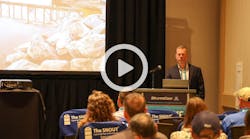Big Improvements for Pacific Coast Highway
About the author:
John Hepfinger is global market director for Milliken & Co. Hepfinger can be reached at [email protected] or 855.655.6750.
A part of Caltrans Highway 1, or the Pacific Coast Highway, located in Big Sur, Monterey County, Calif., has been closed for an extended period of time with crews working every day of the week from dawn to dusk to reconstruct the slope and repair road damage caused by the Mud Creek landslide, which originally affected nearly a half-mile segment of Highway 1 at Mud Creek when the landslide occurred in May 2017.
The highway stretches more than 650 miles, from south of Los Angeles to north of San Francisco, and it passes through Big Sur. Landslides have taken out portions of the highway before, but this particular landslide was much larger than previous occurrences, with a comparable landslide recorded decades earlier. The highway was partially re-opened in July 2018 as a one-lane road while work continues to fully complete the reconstruction.
The closure of Highway 1 caused a significant dip in visitors throughout the region because of a difficult-to-navigate and less-scenic detour by Nacimiento-Fergusson Road, and contributed to fewer overnight stays in the area due to the now-broken scenic highway.
The work will continue in 2019 through the wet season to complete the project so California residents can once again enjoy the scenic route on Highway 1 up and down the coast. John Madonna Construction, from San Luis Obispo, Calif., used some newer construction techniques and products for this project, which include the use of geosynthetic cementitious composite mats (GCCM).
The Solution
A typical solution for this type of job is to cover the infill area with plastic, but Madonna Construction wanted a more permanent and resilient repair for this project to serve as a preventative measure if similar damage occurs in the future. As such, they chose GCCM to complete multiple projects along the highway.
GCCM is a flexible, concrete-impregnated fabric that hardens on hydration to form a thin, durable, waterproof and fire-resistant concrete layer. Essentially, it is concrete on a roll. GCCMs typically are used to replace conventional concretes, riprap, shotcretes and some geotechnical fabrics for a range of erosion control and protection applications.
The GCCM was installed at three locations along Highway 1. The first installation site for the GCCM protected a gravel drainage base along the shoulder of Highway 1 from erosion and storm water runoff. The material also relined an existing concrete drainage ditch showing signs of deterioration and cracking in its second application use. The third application of the GCCM redirected storm water directly to a catch basin.
Concrete Cloth CC-5, which has a 5-mm thickness, was specifically selected based on abrasion and hydraulic conditions. The material thickness depends on the application. Individual GCCM strips were cut and placed to protect a gravel drainage base laid prior to GCCM installation. The seams of the GCCM were shingled in the direction of the storm water and other debris flow that could occur at the site.
Positive Outcomes
GCCM also can provide material savings of up to 95%, and it reduces the need for cement mixing equipment, which can reduce the environmental impact of construction. The material also has a low washout rate compared to other cements and a limited alkaline reserve. It is not classified as an irritant like most concretes and is less damaging to the environment.
Muller Construction Supply from San Jose, Calif., trained workers from Madonna Construction to properly install and hydrate the material according to ASTM Guidelines (ASTM D8173-18). Although the rehabilitation efforts have been underway since May 2017, the portion that included a GCCM took only half of a day with a four-man crew. If the crew had encountered rain during the installation, the materials could have still been installed because Concrete Cloth GCCM can be installed in the rain and other wet conditions, which eliminates most weather-related project rescheduling issues. The need for as quick of a repair as possible made everyone involved conscious of choosing products that would quickly and efficiently make the repairs necessary to bring visitors and drivers back to a safe and completed stretch of Highway 1.
GCCM must be hydrated using a water source, but the material can be hydrated using saline or non-saline water, and the water does not need to be potable. The minimum ratio of water to concrete cloth materials is 1:2 by weight. It cannot be over-hydrated, so an excess of water always is recommended. During this project, the material was hydrated after it was initially placed over the gravel and then again when the drainage ditch was completed. If under-hydrated, the material will not reach its full strength and the setting time could be prolonged. The material can fully hydrate under water from immersion. For this project, water was provided via water truck, but water also can be pumped from an available water source in the installation area.
The Madonna Construction crew temporarily closed the one-lane road (it is used for both directions of traffic by a temporary traffic light) once for 10 minutes to hydrate the Concrete Cloth GCCM with the water truck. If the company used other alternatives, the road closure would have lasted longer and occurred several times throughout the repair. These closures would have caused additional traffic issues and safety concerns.
Over time and in some climates, an untreated GCCM naturally will turn green as the textured top surface allows moss growth. The fiber-reinforced concrete layer, however, will prevent root-growing vegetation. The material easily can be covered by painting with reputable exterior masonry paint.
GCCMs have been used on Caltrans projects for slope protection, soil stabilization, drainage channel rehabilitation and armoring for fire protection. The highest achievable level of fire protection for combustible materials is Euroclass classification B-s1, d0. The U.S. Mine Safety and Health Administration has certified Concrete Cloth GCCM passes ASTP-5011 standards for both vertical and horizontal applications along with its Euroclass classification. Additional rehabilitation uses include secondary berm protection, culvert invert protection and geosynthetic liner protection.
“The GCCM completed the job perfectly,” said Brian McGovern, president of Muller Construction Supply.


